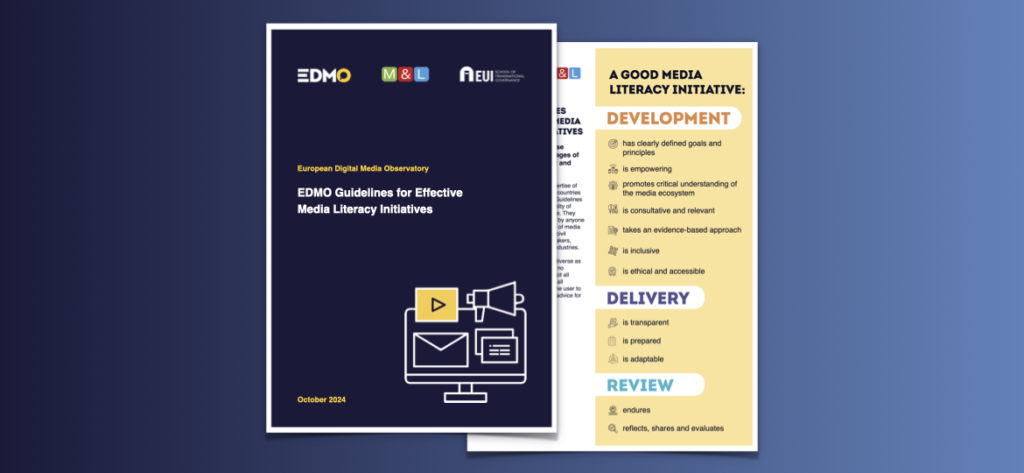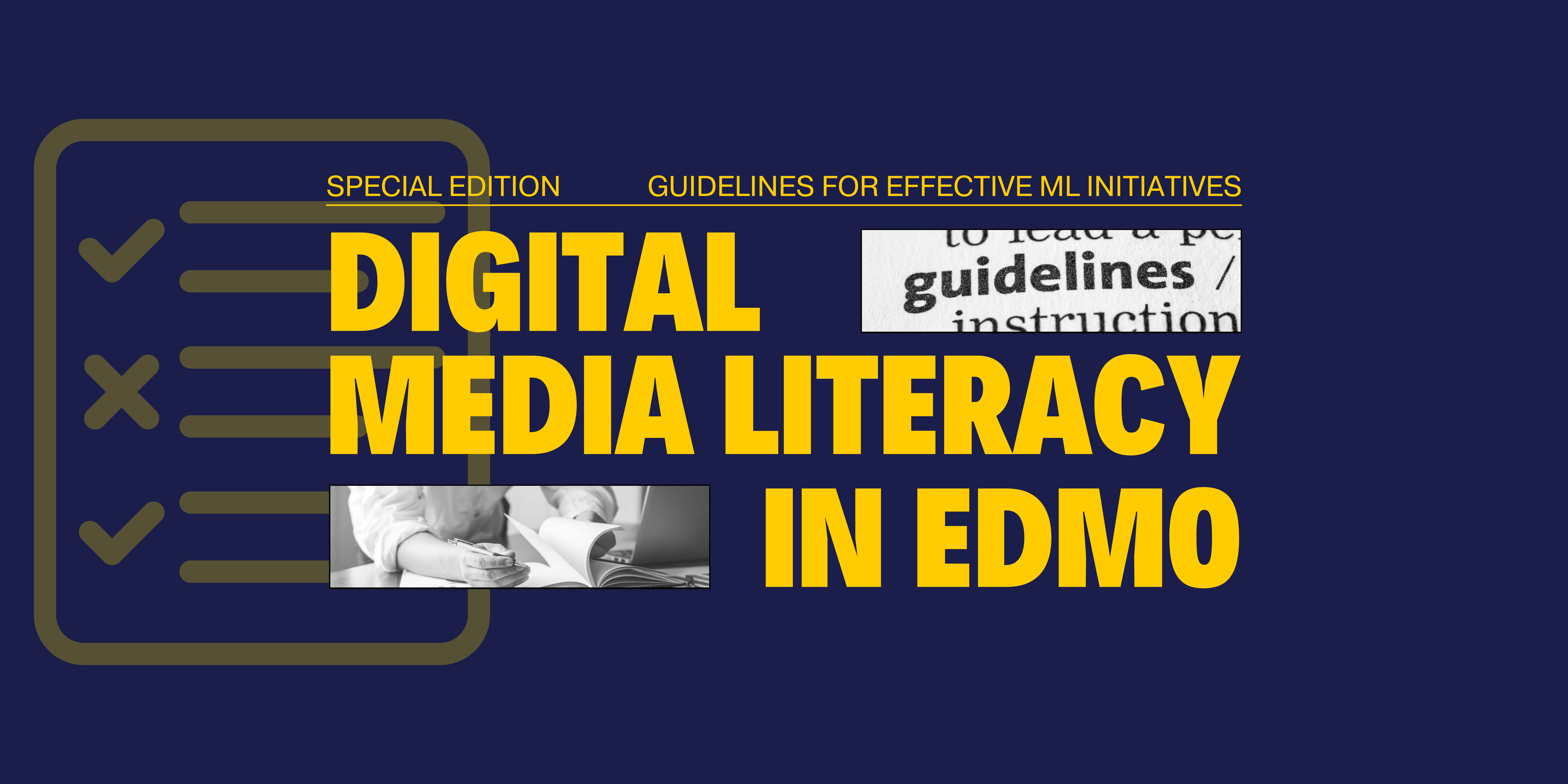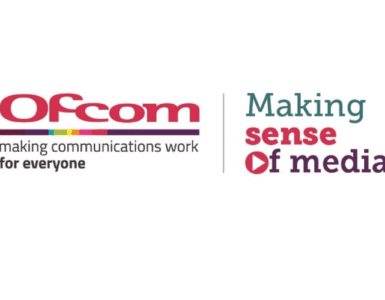This Special Edition of ‘Digital Media Literacy in EDMO’ reflects on the recently published Guidelines for Effective Media Literacy. For more information and to download the Guidelines here.

Sally Reynolds, Media & Learning Association/EDMO; Emma Goodman, LSE/EUI/EDMO; Chloé Pété, Media & Learning Association/EDMO.
What was the main driver behind the development of the EDMO Guidelines for Effective Media Literacy Initiatives in the first place?
Those of us who have been active in the European media literacy community in recent years have witnessed an ongoing debate amongst practitioners, policy-makers and researchers as to how exactly we should define and describe media literacy. Multiple short definitions abound and there is an ever-increasing reference to the importance of critical thinking, but these often lack depth and can be of little use to practitioners, policy-makers or researchers when it comes to setting up or assessing initiatives. Within the EDMO Media Literacy team, we were faced with the task of Establishing quality standards/best practices and policy recommendations, which immediately led us to a discussion about what constituted ‘best’ practice as any such exercise necessitates a comparison or bench-marking exercise against a given set of criteria, and as far as we could see, no such criteria really existed. At the same time, we were reluctant to embark on the exercise of creating such criteria without ensuring the engagement of the wider media literacy community, recognising that our own knowledge and experience represented just a very small part of the media literacy landscape in Europe. That is why we have taken the route that we have, ensuring an ongoing open consultation process with the wider media literacy ecosystem, while at the same time working hard to ensure these guidelines are relevant, effective and tailored to the needs of those targeted.
What is the primary goal of the EDMO Guidelines for Effective Media Literacy Initiatives, and what specific impact do you hope these guidelines will achieve across Europe and beyond?
The primary goal of this work is to provide a clear guide to the different aspects that are worth considering when it comes to setting up and running an effective media literacy campaign or initiative. Naturally, all initiatives differ depending on a whole variety of different factors, however, we argue that many of our 12 principles are worthy of attention as they can help the initiator re-consider and shape their efforts in a way more likely to succeed. By expanding each principle with what we hope is a clear and relevant explanatory text, we hope to bring the wider community on board with our thinking and the rationale that lies behind each principle. By adding high-quality resources and good practices to the explanatory text, our aim is to provide concrete examples to illustrate the different guidelines. At the same, we hope to harvest and share the many, many useful resources already developed by the community at large and to expose such resources to a far broader audience than is currently the case. On a very practical level, we hope that the guidelines can be used not only by practitioners but also by those supporting, promoting and assessing media literacy initiatives more generally as a way to assess the potential effectiveness of different projects, strategies and schemes. Other possible practical applications include their potential use in accrediting teachers and trainers who deliver media education. Finally, in the longer term, we hope to localise this work in order to adapt the Guidelines to different national and regional contexts in the European Union.
Media literacy is a complex field with a variety of approaches and target audiences. Could you explain how these guidelines accommodate such diversity, and how they differ from a “one-size-fits-all” solution?
We are acutely aware of the complexity and diversity of the field and this is why the guidelines deliberately don’t focus on how to tackle a particular aspect of media literacy, or a particular field: we have sought to make them generally applicable to different projects by concentrating on the process of developing an initiative, rather than on its content. The one principle that addresses content is “A good media literacy initiative promotes a critical understanding of the media” which we feel is both sufficiently fundamental and sufficiently widely applicable to highlight specifically, as understanding how the media ecosystem functions and building related critical thinking skills is vital for both protecting people against online harms, and for empowering them in their online activities. As we clarify in the guidelines for this principle, it could include a range of topics, such as explaining the value of independent journalism, or the role of technology companies or of influencers, or how algorithms work or how data flows.
The other principles focus on the process of developing, delivering and evaluating an initiative and include elements that we believe are widely applicable to a diverse range of interventions in the media literacy space, based on shared values of consultation, inclusion and reflection.
However, as we stress in the introduction, this doesn’t mean that all principles and guidelines are necessarily relevant to all projects and we trust that expert practitioners will select those that apply to them. For example, the preparatory process for a mass campaign would be very different to that for a highly targeted training session, and the guidelines might well be used differently.
Crucially, the guidelines are not intended to limit nor discourage the abundance of enthusiastic and passionate work that takes place in this field, but to provide ideas and inspiration for consideration.
Misinformation is evolving rapidly, and media literacy efforts must often respond to new challenges. What are some of the biggest obstacles you foresee in applying these guidelines effectively, and how can practitioners address them?
We believe that despite the rapidly evolving media eco-system in which we live, the fundamentals of what makes for effective media education and the promotion of media literacy across all sectors of the community remain largely the same. The main challenge as we see it is making sure that enough attention and resources are committed to ensuring media literacy for all is taken seriously enough. For example, to date a lot of effort has gone into introducing media literacy in the compulsory education sector and yet only a tiny minority of Europe’s 5 million teachers are sufficiently well trained or resourced to delivery effective media education in the classroom. Study after study highlights the fact that the spreading of disinformation is often the fault of older generations while large scale media literacy activities targeting the over 50s are few and far between. We hope that these guidelines can play at least a modest role in galvanising the media literacy sector to build on their strengths and growing community, highlighting factors for success, avoiding duplication of effort and ensuring the necessary resources and attention to make all sectors of society sufficiently media literacy to face the challenges ahead.
EDMO encourages community involvement. How can media literacy practitioners endorse the guidelines, and what benefits might endorsement bring to their own work?
Still driven by the desire to involve the entire media literacy community and ensure full transparency, we initiated an endorsement call before the official publication of the guidelines. Stakeholders across sectors—NGOs, networks, researchers, fact-checkers, journalist organisations, ministries, regulatory authorities, and broadcasters—were invited to participate. As of today, the guidelines are endorsed by over 70 organisations from more than 28 countries across Europe and beyond. Any organisation interested in supporting and endorsing these guidelines can reach out to us at edmo@eui.eu for further details. For us, these endorsements demonstrate the vast and diverse nature of the media literacy community and highlight the importance and need for these common guidelines.
You’ve also invited practitioners to submit resources and examples of good practices. Can you share more about this collection process, and what type of resources or practices are you looking for?
We believe that the guidelines will be easier to understand and follow if accompanied by concrete examples, and we believe that the media literacy community will be strengthened by increased knowledge sharing about the initiatives that are taking place, and their successes and failures.
Therefore, we are looking for examples of initiatives that effectively illustrate one or more of the principles which we will then describe and link to on the EDMO website, and we invite people to propose initiatives that they believe would be a good fit.
Finally, what are the next steps for EDMO in making these guidelines accessible across Europe? Are there specific plans for expanding their reach, such as translations, workshops, or regional partnerships?
We hope that the guidelines will be translated into the languages of all EU member states, and others. Localised examples of initiatives would further expand the guidelines’ accessibility.
For more information and to download the full document, visit: https://edmo.eu/areas-of-activities/media-literacy/raising-standards/
Endorsing the Guidelines
Would you like to give your support to our work by endorsing the EDMO Guidelines for Effective Media Literacy Initiatives? Then contact us on edmo@eui.eu for more details.
Adding a Resource or Good Practice
Are you interested in proposing the inclusion of either relevant resources or an example of good practice to the EDMO Guidelines? Then contact us on edmo@eui.eu for more details.














